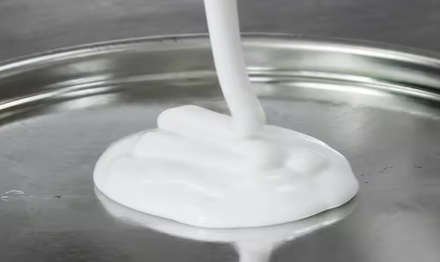A cola branca (adesivo PVA) tem um desempenho poderoso, mas seu desempenho e eficiência de produção são constantemente ameaçados por um oponente astuto: a espuma. Entender e controlar a espuma não é opcional; é fundamental para a qualidade e a lucratividade.
Por que a cola branca espuma constantemente:
-
Surfactantes necessários: Os surfactantes são necessários para a estabilidade da emulsão, eles reduzem a tensão superficial, resultando no aprisionamento de ar durante a mistura, bombeamento, enchimento ou aplicação (pincelada, enrolada, pulverizada).
-
Interferência mecânica: agitação durante a produção e técnicas vigorosas de uso final podem injetar ar violentamente.
-
Ameaça da microespuma: Bolhas minúsculas e persistentes presas em líquidos podem causar defeitos muito tempo após a mistura inicial.

O verdadeiro custo da espuma descontrolada:
-
Problemas de produção: transbordamento, desperdício de produto, baixa velocidade da linha de envase, limpeza tediosa, tempo de inatividade.
-
Problemas de qualidade: vazios e irregularidades no filme adesivo podem levar ao enfraquecimento da adesão e à falha.
-
Desafios da aplicação: Defeitos superficiais como furos, marcas, olhos de peixe e bolhas visíveis podem prejudicar a estética e a adesão.
-
Ineficiências ocultas: o ar preso reduz a densidade do adesivo, o que significa adesivo menos eficaz por volume e adesão potencialmente mais fraca.
Antiespumantes: Soluções de Precisão
Soluções universais falham.
Antiespumantes PVA eficazes
são sistemas de precisão projetados para:
-
Entra em cena as bolhas de espuma.
-
Difunde-se rapidamente por todo o filme de bolhas.
-
Rompe e quebra bolhas por meio de mecanismos como formação de pontes de partículas hidrofóbicas e aumento localizado da tensão superficial.
-
Inibe a formação de espuma: Oferece proteção duradoura contra a regeneração da espuma durante o processamento, armazenamento e aplicação.
Escolher o antiespumante certo é fundamental:
-
Compatibilidade em primeiro lugar: não deve desestabilizar emulsões delicadas de PVA (sem partículas, delaminação, turvação).
-
Dupla ação: elimina a espuma da superfície e inibe a microespuma persistente.
-
Persistente: Resiste à desativação (emulsificação) ao longo do tempo e da pressão.
-
Adequação da aplicação: eficaz sob condições específicas de uso final (por exemplo, revestimento de alta velocidade).
-
Clareza e conformidade: mantenha a clareza necessária e atenda aos requisitos regulatórios (contato com alimentos, COVs, brinquedos).
Além do pop inicial: desempenho duradouro
Antiespumantes de qualidade
trabalhe silenciosamente e ao longo do tempo para garantir o controle eficaz da espuma durante todo o ciclo de vida do adesivo, desde os tanques de produção e tambores de armazenamento até a aplicação pelo usuário final.
A formação de espuma é um desafio inerente aos adesivos PVA, mas não precisa comprometer a qualidade ou a eficiência. Antiespumantes projetados com precisão são essenciais, embora muitas vezes despercebidos, para proteger a produção, garantir um desempenho adesivo consistente e garantir os resultados financeiros. Trabalhar com especialistas em tecnologia antiespumante é fundamental para formular adesivos brancos de qualidade superior.
